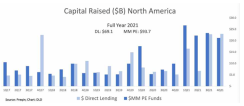The addition of private credit to institutional portfolios has increasingly caught the attention of asset allocators, with many of them increasing exposure to the asset class – some, no doubt, based on the resilience it has demonstrated throughout the Covid pandemic.
As its name suggests, the private credit team at PineBridge Investments is focused on this market. To gain insights on the outlook for the lower-middle-market direct lending asset class, II sat down with two leading professionals from PineBridge Private Credit: Joe Taylor, Managing Director, Head of Capital Markets; and Doug Lyons, Managing Director, Head of Origination.
II: Why do you think private credit proved so resilient through the pandemic?
Joe Taylor: Private credit shops should always be underwriting investments to a recessionary period, and it was important to them to have their portfolio perform well on a relative basis during the pandemic period. The depth of diligence around a few key factors is a good indicator regarding how well a portfolio likely performed: ensuring sufficient liquidity cushions around investments; ensuring balance from an enterprise value perspective; and partnering with the right fiduciaries, both private equity buyers of these platforms and the management teams operating the companies.Doug Lyons: In the underwriting process it’s important to assess the capabilities of a management team. The necessity to navigate various Covid-related challenges was an opportunity for strong management teams at equity sponsors and companies to shine and demonstrate their expertise.
Taylor: The timing of when the pandemic hit the economy created a forced optimization that was otherwise not in the immediate plan at many companies. In the early stages of the pandemic there was uncertainty around how long it would last. For companies to survive, everyone had to quickly evaluate and manage the entire organization. That meant assessing their workforce, managing resources from a remote tech perspective, cutting costs, and maximizing efficiency. Quite a few companies benefited from this forced optimization and emerged from the pandemic as much more efficient operations. An interesting twist to how companies negotiated the pandemic in the U.S., however, was the Paycheck Protection Program. It created an artificial floor that perhaps kept afloat some companies that probably should have undergone a restructuring. The health of those companies in a recessionary period or pandemic resurgence remains to be seen.

Nimble companies that adapted and transitioned tactically to meet short-term demand tended to survive the pandemic. How can they carry that forward?
Lyons: Here’s an example of a successful transition by a middle-market company during the pandemic: A manufacturer of hand lotion shifted its operations to produce hand sanitizer. In some scenarios like that, earnings may have doubled or even tripled. That’s a good thing, but the challenge is ongoing. Are customers going to continue buying five-gallon containers of hand sanitizer next year? Quick pivots by management to transition a company into a profitable product to capitalize on driving market demands can be impressive – but at the same time, sound investment decisions require an eye on potential shifts in the related macro environment.Many middle-market companies successfully transitioned or accelerated their marketing and sales efforts to online and direct-to-consumer channels during the pandemic. Customers have become more accustomed to shopping online, a trend that was further exacerbated by stay-at-home mandates. The conversion to more online and digital product marketing, including direct sales to consumers, is a trend we expect to continue.

There’s a tendency to think of the mid-market or lower middle-market as being small. What’s the size of the opportunity overall?
Taylor: There’s a large market opportunity in the U.S. for lower and mid-market companies requiring access to capital, representing approximately US$500 billion based on our team’s estimates. These are not distressed or turnaround situations. They’re comfortable where they are, but their product or service could be expanded with the right professionalization and access to capital. That’s where private equity firms and their private capital relationships come in. The right partnership and capitalization can take strong private companies, transition them to private equity ownership and help smooth the bumps along the way to growth.If you run one of the companies you just described, why not go to a bank for capital?
Taylor: Banks have limitations on how much they can hold per investment, and it’s not the same magnitude that can be provided by private marketplace lenders. A bank also might be unable to manage a turbulent period for a company it's invested in – that puts their capital at risk, which can be the result of regulatory oversight. So, the types of lower-middle-market businesses I’m referencing focus on the right partnership and relationship – even if it does cost a bit more than a bank loan.What should institutional investors consider when completing due diligence across direct lenders?
Lyons: Focus on the portfolio and management team. Is there diversity by industry, equity sponsor, and investment size? To build an effective risk-adjusted portfolio in the middle market, we believe it’s important to have a large variety of investments across multiple borrowers, in contrast to focusing large amounts in one or two companies. Track record and historical experience of the manager should be thoroughly examined. What is the background of the management team and employees? How much experience do they have working together? Have they achieved their stated goals?Taylor: Beyond return – which is obviously significant – this is a less liquid asset class that requires more thorough due diligence. It also requires comfort around the actual valuation and price of individual underlying assets because there’s no third-party mark for comparison. As a limited partner, what is the level of transparency you have into those metrics and how they’re being measured?
You never want a situation where one day you have a par style asset and the next quarter it’s down at 50 cents. That should be very rare in this asset class. There could be degradation within these assets, but if that happens the management team should be addressing it early, be transparent, and have the resources to manage deterioration and recover the asset. Your partner should be able to simultaneously manage multiple such situations – losses in this asset class are hard to recover.
Lyons: Institutional investors should focus on the type of securities underlying the portfolio. Some private credit managers lean more toward mezzanine, while others focus on first lien, second lien, or unitranche. With any structure, it’s important to see through the yields to figure out exactly what risk is being assumed to obtain them.
Investors have a lot of choices. What are the key benefits they might derive from a private credit direct lending allocation?
Taylor: Historically, private credit has lacked volatility, and investors are typically able to get money out to work on a more consistent basis with less impact from external forces. It’s also an asset class that has been a very good performer with respect to default and recovery rates. Calendar year returns for the asset class, measured by Cliffwater Direct Lending Index – Senior Only, were 9.90%, versus 5.28% for the Bloomberg High Yield Bond Index and 5.20% for the S&P/LSTA Leveraged Loan Index, as of December 31, 2021. It is a good foundation around which to build opportunistic or other distinct strategies. In an overall diversified alternative platform, we would expect multiple private credit platforms focused on different sectors to present a strong foundation and yield opportunity for investors.
We are now in a rising interest rate environment. What do you anticipate as some of the headwinds and tailwinds for private credit direct lending?
Lyons: Private credit is predominantly a floating-rate strategy, so as rates rise, private credit has historically benefited. Although the debt tranche yield may be floating, in this inflationary environment market participants should want to feel confident that the portfolio companies can generate enough liquidity to cover their rising cost structures and provide an adequate cushion to debt service requirements.Taylor: That raises another diligence point potential investors should bear in mind – how do the underlying portfolio and the managers view EBITDA adjustments? How much cushion of actual free cash flow are these companies generating today? A company may look terrific three years from now, but what does it look like today? Private credit is a floating-rate instrument on the yield, but market participants should make sure there is ample cushion through cash liquidity coverage for the companies underlying their investments as their business models get hit by additional costs or inflation.
There is some permanency now with inflation. It’s going to be around for a while through wages and the resulting challenges with workforce recruitment and retention for the type of companies we’re describing. The market has shown overall strength, but continued wage increases could cause issues.
Prior to the Ukraine crisis, supply chains showed some stabilization. Now, the focus is on how much of a revenue increase pass-through you can get from a company’s customer base. Last year, some companies saw their customers easily absorb volume and price increases. Today, that could be more challenging and likely depends on how global macro events emanating from Ukraine affect companies up and down the supply chain. We are also closely monitoring the recent spike in energy costs and oil derivatives. It will likely have a near-term impact on margins, but the severity will be highly dependent on the type of business model you are financing.
Lyons: The private credit market is not immune to the labor issues being experienced throughout the economy. There’s a labor shortage, and as Joe mentioned, an increasing pay scale to get the necessary labor. Good companies and good management teams are dealing with it in different ways, but it’s a macro factor we’re closely watching.
Taylor: Different Covid variants and additional restrictions may come down the road, too. Those possibilities must be incorporated into every investment process at this juncture. The possibility of Covid resurgence is something investors should consider, given the varied impacts according to industries and sectors.
Given those macro points, how do you anticipate the asset class might perform in the near and longer term?
Lyons: Market participants should target private companies that have demonstrated a strong, growth-oriented business model and the ability to effectively compete in their marketplace. The size and breadth of the middle market creates a rich opportunity set across multiple industries. It’s possible we could experience a recessionary environment over the next few years, but we believe the asset class will continue to perform well. Covenants in credit agreements allow managers to work with a company during difficult times, protecting downside risk and making certain there is a collective approach toward operational modifications.Are there sectors in the lower middle market about which you’re especially excited?
Lyons: We’re excited in general about companies that have demonstrated the ability to navigate the challenges the pandemic presented and have prospered, regardless of sector. The pandemic allowed certain middle-market companies to demonstrate the viability and attractiveness of their service offering and products. These companies have proven management teams and resilient business models. Their customers have stuck with them and in many situations increased purchasing. Those are some of the leading criteria that get me excited about an investment.Taylor: Certain parts of the market have been historically stable and are expected to continue for the foreseeable future. The best advice, in my view, for an LP is to ask: Does the manager know what they know, and know what they don’t know? Consistency and context are key, and it’s important to take the full context of a manager’s history into account when making allocation decisions. Changing strategy or stripes or moving to a certain sector because it’s hot at the moment is not a good investment thesis. We believe partnering with sponsors with strong investment track records in supporting lower-middle-market companies operationally and financially to grow through varied macro environments – with deep knowledge, experience, and networks in the sectors in which they invest – can set investors up for success.
For more insights on private credit markets, visit pinebridge.com.
Investing involves risk, including possible loss of principal. The information presented herein is for illustrative purposes only and should not be considered reflective of any particular security, strategy, or investment product. It represents a general assessment of the markets at a specific time and is not a guarantee of future performance results or market movement. This material does not constitute investment, financial, legal, tax, or other advice; investment research or a product of any research department; an offer to sell, or the solicitation of an offer to purchase any security or interest in a fund; or a recommendation for any investment product or strategy. PineBridge Investments is not soliciting or recommending any action based on information in this document. Any opinions, projections, or forward-looking statements expressed herein are solely those of the author, may differ from the views or opinions expressed by other areas of PineBridge Investments, and are only for general informational purposes as of the date indicated. Views may be based on third-party data that has not been independently verified. PineBridge Investments does not approve of or endorse any republication of this material. You are solely responsible for deciding whether any investment product or strategy is appropriate for you based upon your investment goals, financial situation and tolerance for risk.
PineBridge Investments is a private, global asset manager focused on active, high-conviction investing. We draw on the collective power of our experts in each discipline, market, and region of the world through an open culture of collaboration designed to identify the best ideas. Our mission is to exceed clients’ expectations on every level, every day. As of 31 March 2022, the firm managed US$146.0B across global asset classes for sophisticated investors around the world.






